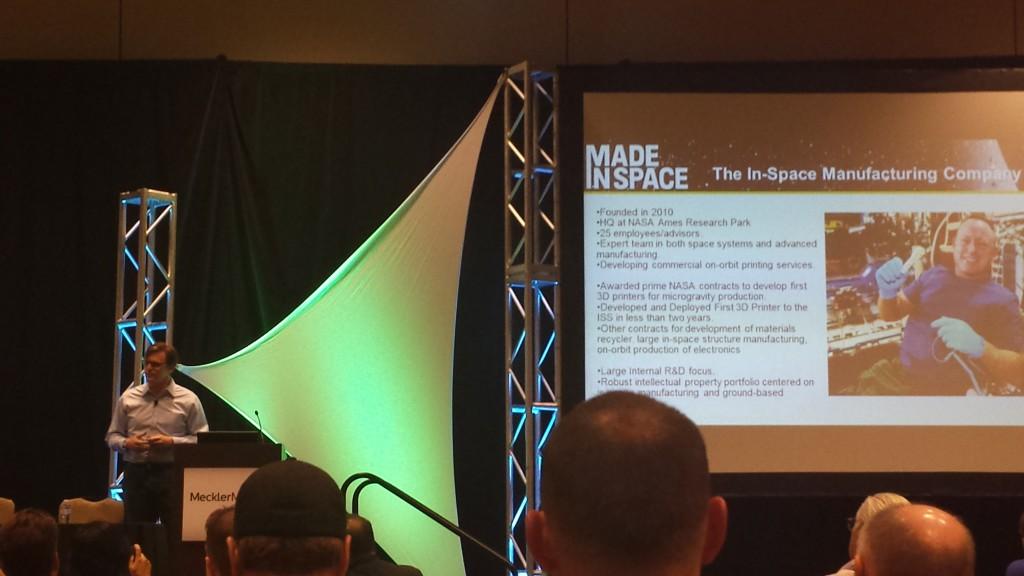Following my morning cup(s) of coffee, I had the pleasure of starting my day out by walking into the keynote presentation given by Andrew Rush, president of Made In Space, as Inside 3D Printing really kicked off here in sunny Santa Clara. The keynote, “The Era of In-Space Manufacturing Has Begun,” certainly started this conference, put on by MecklerMedia, with a bang, bringing our attention to the literally out-of-this-world applications of 3D printing technology.
 In 45 minutes, Rush walked an attentive audience through the history of his company as well as its ambitions to realize in-space additive manufacturing as a more common occurrence. Founded in 2010–well before most of us in the room had begun to grasp the true potential of 3D printing in real-world applications, Rush said to a laughter of agreement–Made In Space was created with a “goal to live and work better in space.”
In 45 minutes, Rush walked an attentive audience through the history of his company as well as its ambitions to realize in-space additive manufacturing as a more common occurrence. Founded in 2010–well before most of us in the room had begun to grasp the true potential of 3D printing in real-world applications, Rush said to a laughter of agreement–Made In Space was created with a “goal to live and work better in space.”
As space exploration becomes more possible and more accessible by the day, organizations like NASA have been focused on getting there. Made In Space realized, though, that “when you get to Mars or get to the moon, you’re going to need tools,” as Rush explained. For the astronauts and other explorers who need these tools, key considerations include how to get them, how to meet needs that arise in real time, and how to replace lost or broken tools, among others.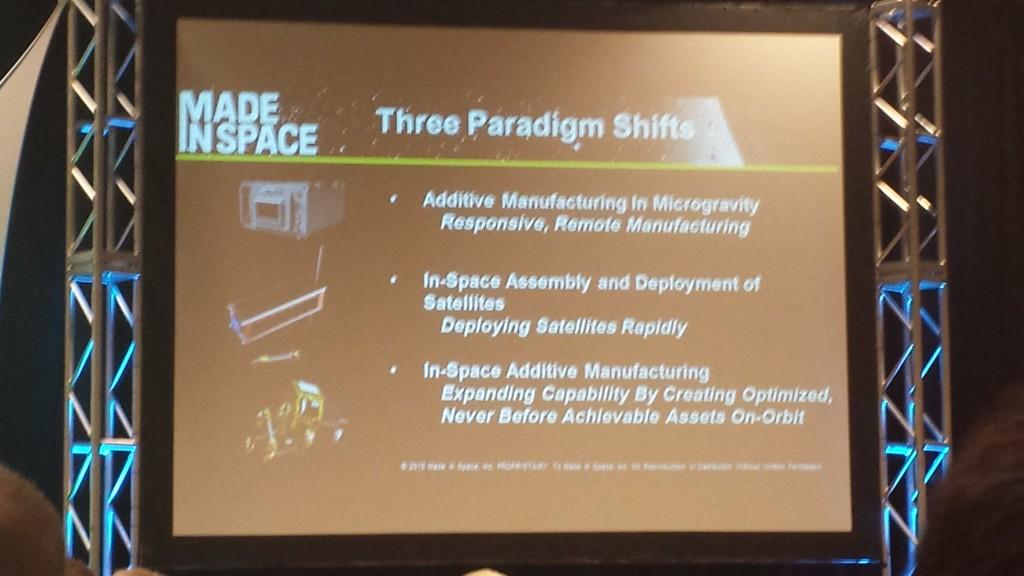
“A 3D printer is like a meta-tool,” Rush said. “It can self-replicate and even self-build, while making other tools.”
For any tool or piece of equipment to be useful in space–relating directly to the International Space Station (ISS)–it has to first get there. This can be incredibly problematic, as a critical part of that process determines how realistic it is to expect any hardware to be put into use: the launch. This less-than-10-minute window is so incredibly stressful to a payload that the logistics must be spot-on to ensure safe, intact arrival. 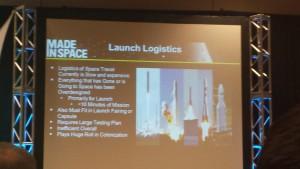
“Everything that has Gone or is Going to Space has been Overdesigned,” Rush’s presentation laid out, “Primarily for launch.”
Components that fail, either during launch or while in use on the ISS, certainly hold up progress that can be achieved. While some failures are potentially catastrophic, others are simply inconvenient. Inconvenience in orbit tends to be a little more inconvenient than misplacing a tool at home. In any event, NASA took a hard look at how they might combat such failures onboard, and the answer probably won’t surprise anyone familiar with next-gen tech: additive manufacturing holds extreme promise to save the day.
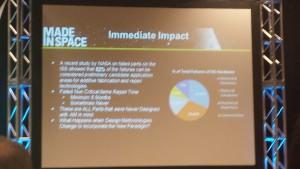 NASA’s data analysis showed that fully 82% of components that failed on the ISS “can be considered preliminary candidate application areas for additive fabrication and repair technologies.” These components, Rush made sure to point out, “were ALL Parts that were Never Designed with AM in mind.” However, turning instead to an onboard 3D printer, the typical answers to failure–a minimum 6-month replacement window or lack of repair for non-critical items–could be forestalled.
NASA’s data analysis showed that fully 82% of components that failed on the ISS “can be considered preliminary candidate application areas for additive fabrication and repair technologies.” These components, Rush made sure to point out, “were ALL Parts that were Never Designed with AM in mind.” However, turning instead to an onboard 3D printer, the typical answers to failure–a minimum 6-month replacement window or lack of repair for non-critical items–could be forestalled.
The first Made In Space 3D printer, sent up to the ISS in September 2014, was the size of a breadbox, and set straight to work on producing increasingly complex objects, from a faceplate to tools, with the first 20 tools created via pre-loaded files sent up with the printer. The 21st print, though, was a torque wrench that represented “The fastest anything has ever gone to the Space Station,” as it was turned from an emailed file to a physical wrench in an incredible two hours. The longest part of that process, Rush said with a grin, was the time it took ISS Commander Butch Wilmore to get to the printer to remove the wrench from the build plate (“Astronauts are very busy!”).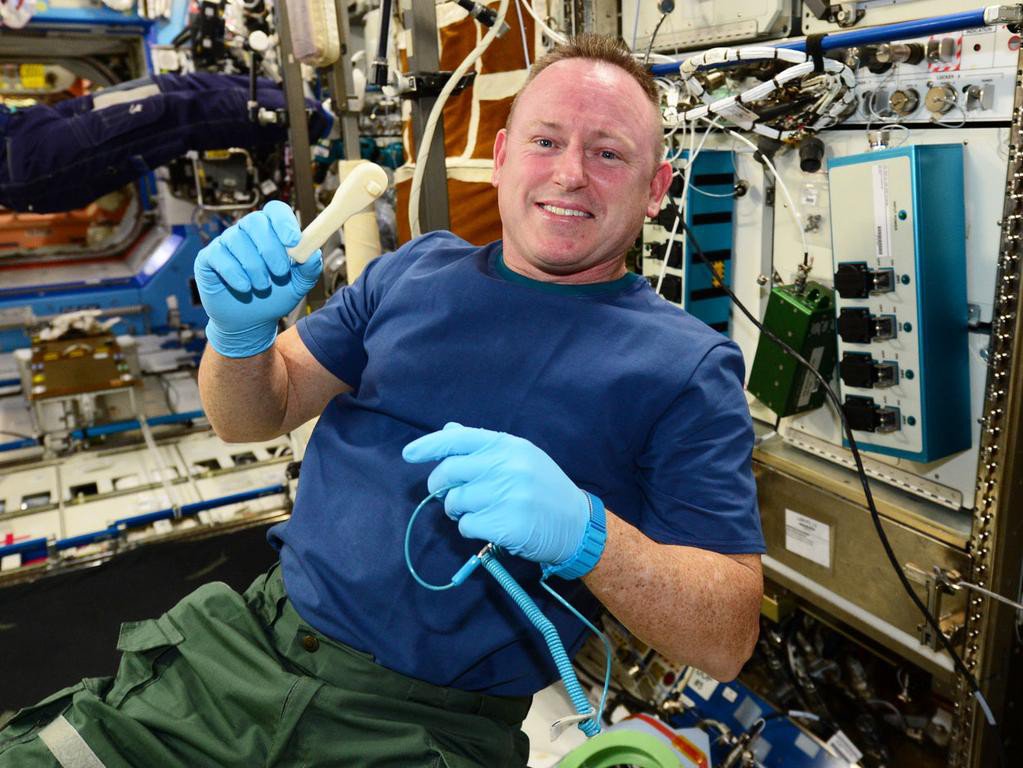
Next up for Made In Space is their upcoming next-gen AMF machine, which will launch this year. Smaller than a microwave oven, the AMF has a 10 x 10 x 20 cm build area, and can print in various materials already including ABS, HDPE, and PEI/PC, and upgradeable to print low-temperature metals and eventually multi-material operations.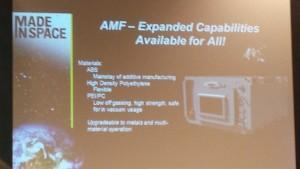
On the materials side of things, Rush was very clear:
“Recycling is key,” he said, “for Earth-independent production.”
Prints made off-planet must be made in a renewable, accessible, safe manner. Made In Space already works with a thermoplastic recycler that turns plastics like sandwich bags into functional 3D printing filament. The company is looking as well at using native materials. Addressing the potential use of regolith gathered from a site on the moon, Rush noted that that would be “pretty cool to put on a resume.” Prints made using Made In Space’s technologies are designed to be created without support, as removing small structures can produce a strong risk of debris.
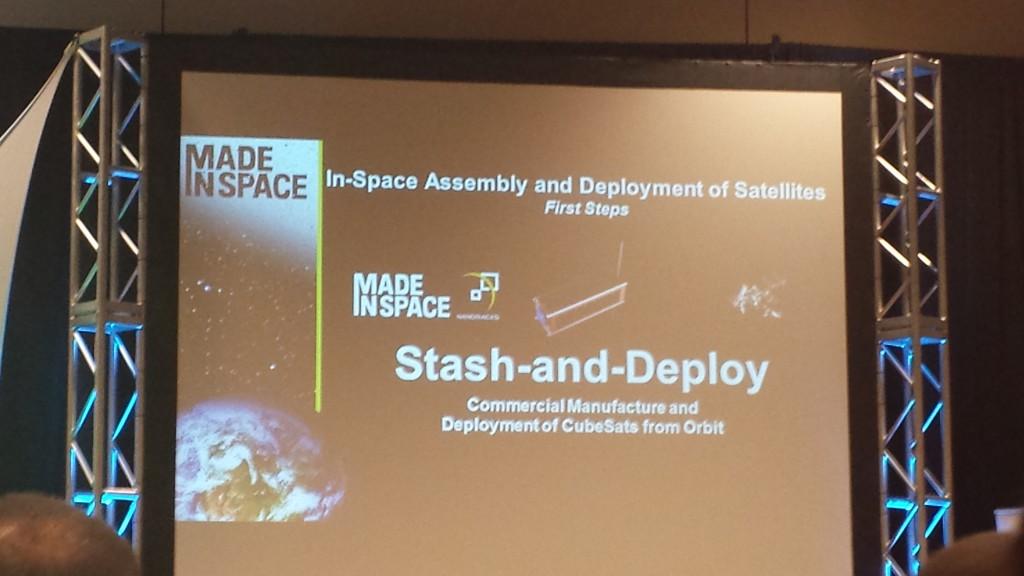 As time marches forward, Made In Space is keeping an eye on the bigger picture. With the ISS’ projected shutdown in 2024, the company is looking at commercial space stations and in-space production of satellites. Being able to assemble and deploy satellites in space (made primarily of PEEK and PEI/PC materials), highlights for especially the potential of CubeSats include a faster launch, a reduction of testing costs, and being more responsive to changing conditions.
As time marches forward, Made In Space is keeping an eye on the bigger picture. With the ISS’ projected shutdown in 2024, the company is looking at commercial space stations and in-space production of satellites. Being able to assemble and deploy satellites in space (made primarily of PEEK and PEI/PC materials), highlights for especially the potential of CubeSats include a faster launch, a reduction of testing costs, and being more responsive to changing conditions.
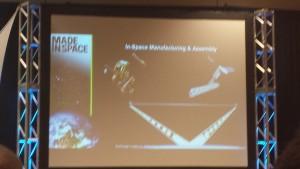 As Inside 3D Printing Santa Clara continues, 3DPrint.com is on the floor catching keynotes and checking out exhibitors. You can follow updates on Twitter at #I3DPConf to stay tuned to the latest from Santa Clara. Staff writer Scott Grunewald and I are both live tweeting during the event, so keep an eye out!
As Inside 3D Printing Santa Clara continues, 3DPrint.com is on the floor catching keynotes and checking out exhibitors. You can follow updates on Twitter at #I3DPConf to stay tuned to the latest from Santa Clara. Staff writer Scott Grunewald and I are both live tweeting during the event, so keep an eye out!
Subscribe to Our Email Newsletter
Stay up-to-date on all the latest news from the 3D printing industry and receive information and offers from third party vendors.
You May Also Like
Why Corrosive Resistant Materials Are Important to the Success of 3D Printing Across Industries
The adoption of additive manufacturing (AM) is accelerating across many major industries. As this technological shift unfolds, the importance of corrosion resistance has emerged as a challenge for 3D printing...
America Makes Announces IMPACT 2.0: $6.6M in New 3D Printing Funding
America Makes, the Manufacturing Innovation Institute (MII) based in Youngstown, Ohio, has announced IMPACT (Improvement in Manufacturing Productivity via Additive Capabilities and Techno-Economic Analysis) 2.0, a project call which will...
3D Printing Webinar and Event Roundup: April 14, 2024
We’re starting off the week’s 3D printing webinars and events at ASTM AMCOE’s 11th Snapshot Workshop and MACH Exhibition. Stratasys continues its advanced training courses, SME is holding a virtual...
AMUK Welcomes Airframe Designs as British 3D Printing Industry Grows
While the UK is not the hub for 3D printer and materials manufacturers as other nations, the country continues to excel at the research, development, and application of additive manufacturing...


